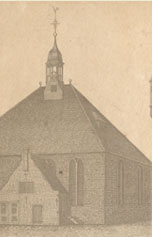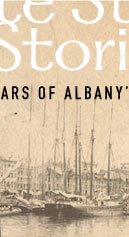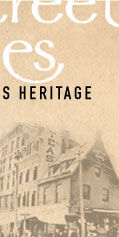
Opening Reception
Photographs |
Many American cities boast a historic thoroughfare that echoes with stories
of power and change, caution and preservation. But how many cities can
boast a 350-year-old street whose past bears the imprint of a New World
explorer, a willful Dutch-born governor, two signers of the Declaration
of Independence, and three United States presidents? Henry Hudson, Peter
Stuyvesant, Benjamin Franklin, Philip Livingston, Abraham Lincoln, Theodore
Roosevelt, and Franklin Delano Roosevelt are among the many luminaries
who made a mark on Albany’s State Street. Stories of bold vision
and passionate conviction, matched by tales of expedient measure and calculated
return, are all part of State Street’s 350-year running narrative;
taken together, they are the stories that shape this exhibition.
State Street Stories: 350 Years of Albany’s Heritage begins
with the story of a trail into the woods, traveled first by Native peoples
and then by Dutch traders who eventually dubbed it Joncker-Straet (Young
Gentlemen’s Street). But in less than a hundred years State Street
emerged as Albany’s main route, the city’s political, religious,
and commercial center. Its strategic location made it an ideal crossroad
for an energetic colonial populace that came from around the world, either
by choice or by coercion, to work and live along the Hudson River’s
northern shores.
Historical records reveal stories of how Albany’s earliest citizens
interacted with one another. Collaborations and antagonisms abounded,
yet despite religious, cultural, and ethnic differences, a guarded tolerance
emerged. Alongside these recorded stories are the voices of silent toil:
slaves, laborers, domestics. Look for their stories between the lines
of State Street’s official history. Collectively, these narratives
form a dynamic blueprint that defines State Street’s current contours.
As State Street grew in prominence, its architecture reflected the civic
and entrepreneurial ambitions of its wealthiest inhabitants. By the early
nineteenth century, Albany’s elite had renounced State Street’s
provincial look, instead searching out renowned architects who could echo
the current visions of American prosperity and refinement. Philip Hooker,
Richard M. Upjohn, Russell Sturgis, H.H. Richardson, and Marcus T. Reynolds
formed the nucleus of architects who recreated State Street as a cornucopia
of nineteenth-century revivalist styles. Today, State Street reveals vestiges
of Albany’s boom times as well as its downward spirals. Although
blemishes and obstructions exist, ultimately these quick fixes are overshadowed
by the enduring grace and elegance of the street’s finest architectural
aspirations.
Lower State Street’s two grandest buildings, the Delaware &
Hudson Building at its base and the New York State Capitol at its hilltop,
are State Street Stories’ visual and narrative anchors. Emblematic
of State Street’s ruling passions, commerce and government, these
two buildings serve as a framework for understanding the path from past
to present. What did State Street look like fifty, one hundred, two hundred
years ago? Who lived and worked there? Why had they come in the first
place? State Street Stories combines historical and anecdotal accounts
with a wealth of archival material—maps, books, hotographs, paintings
culled from Albany’s premier public and private collections—to
form a 350-year visual narrative of how the sometimes noble, often misguided
calculations of Albany’s citizens ultimately turned a trail in the
woods into one of America’s most historic city streets.
|




